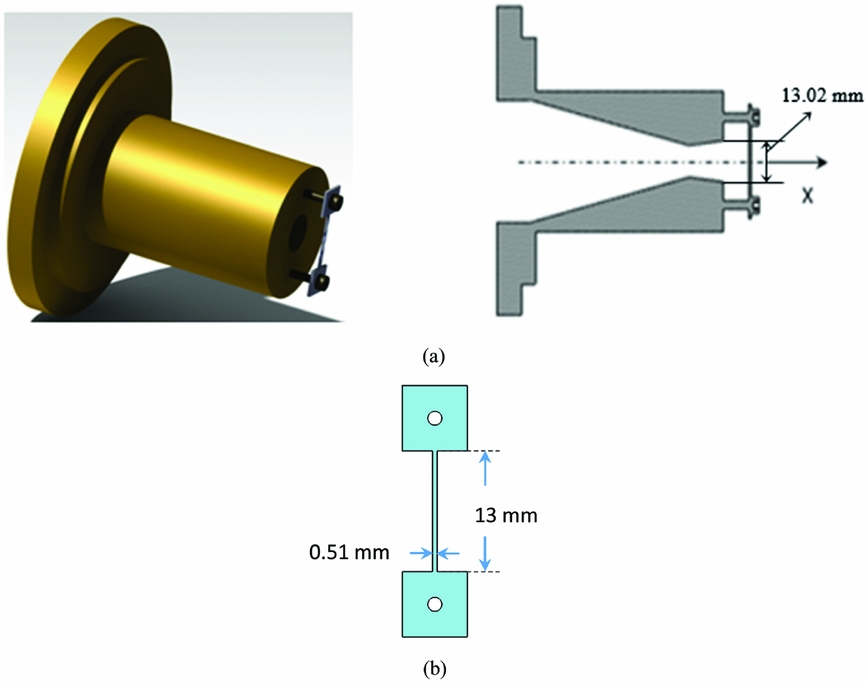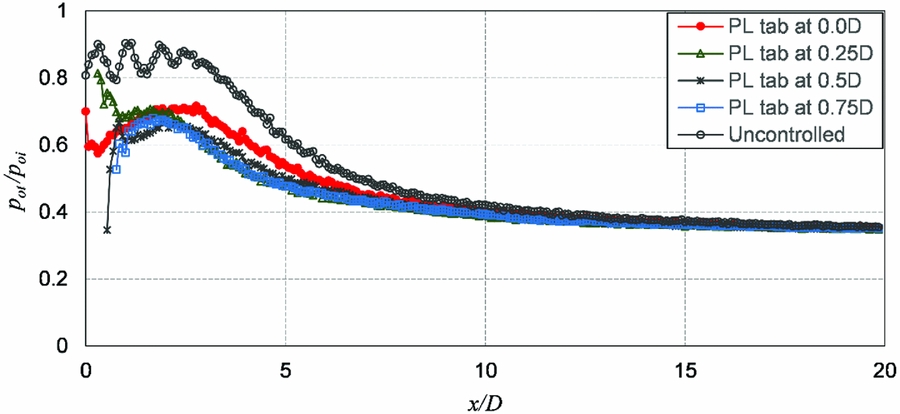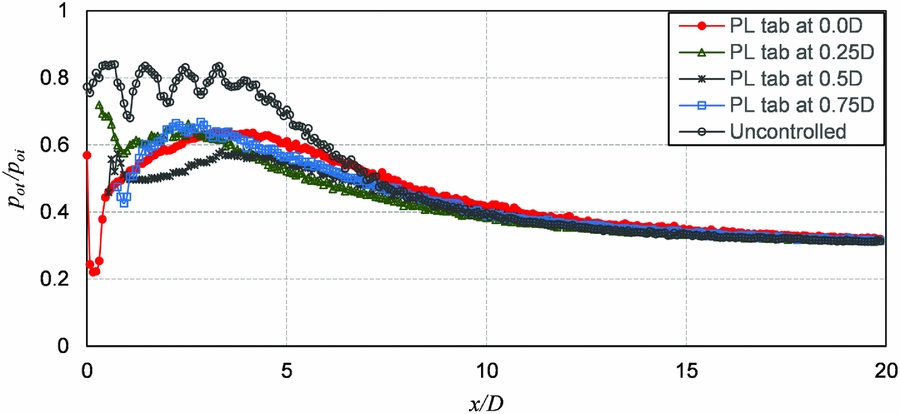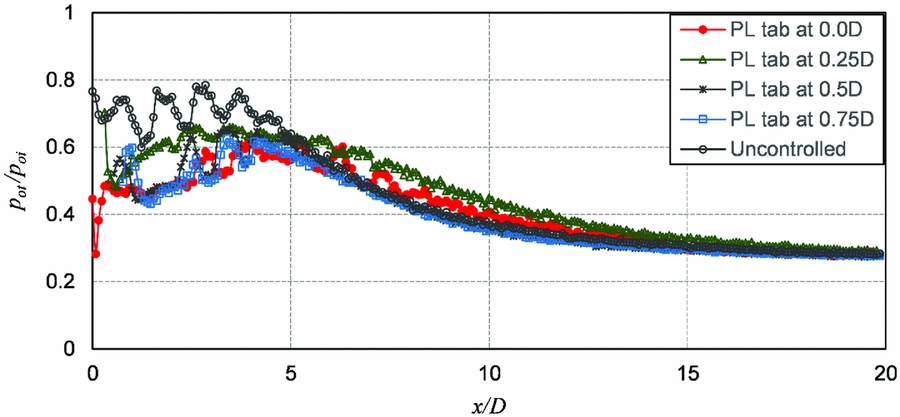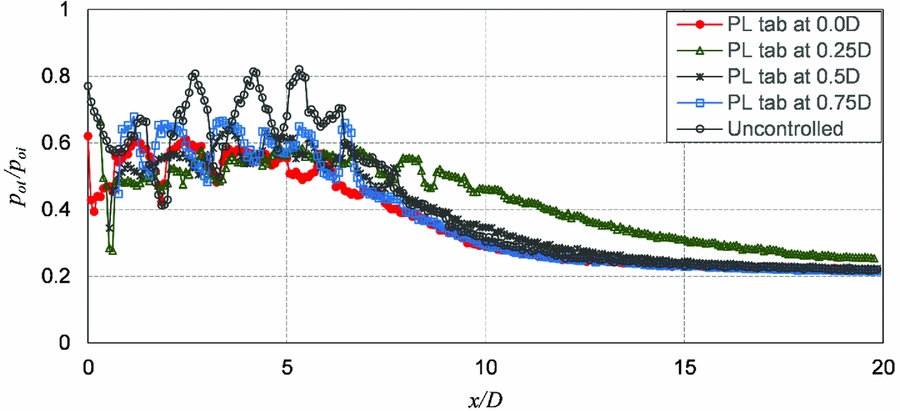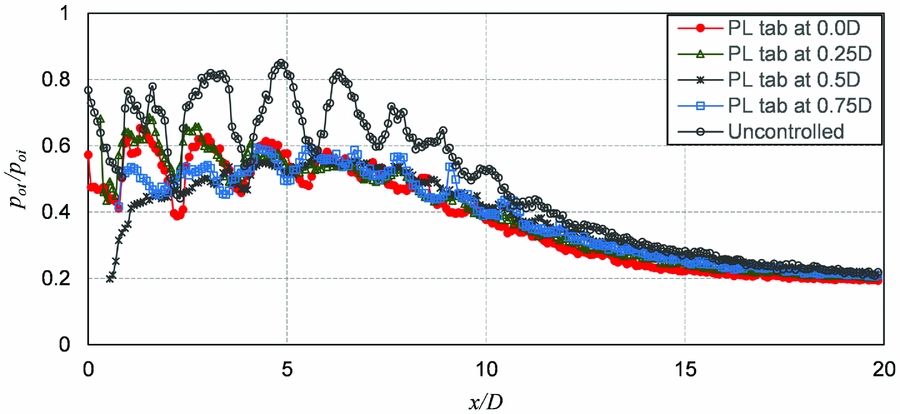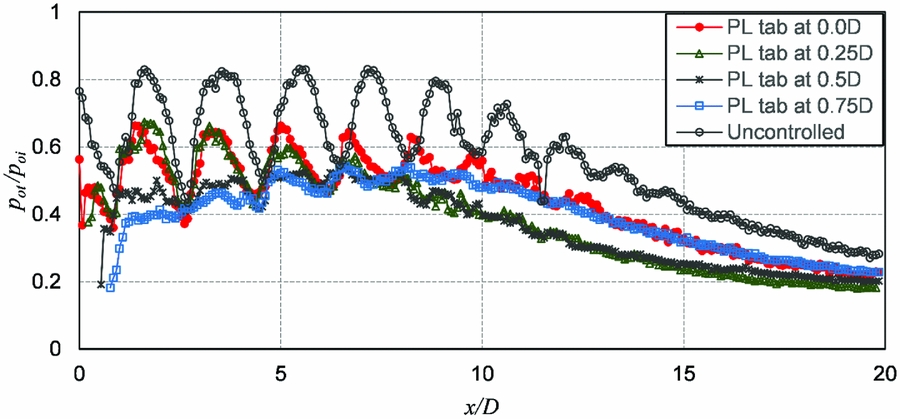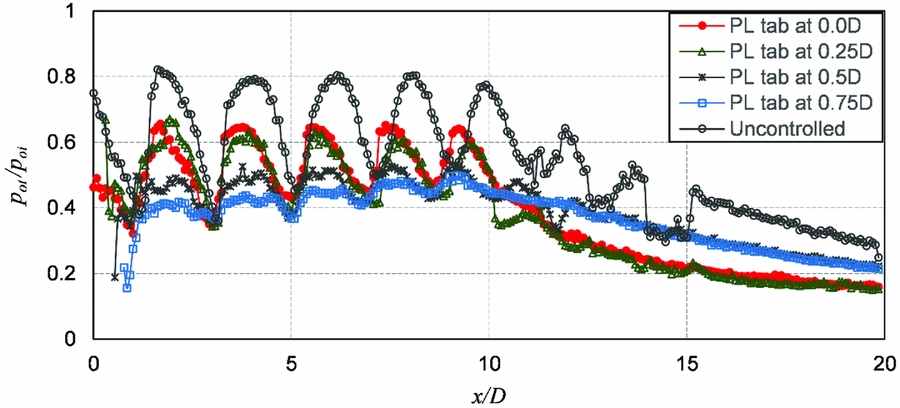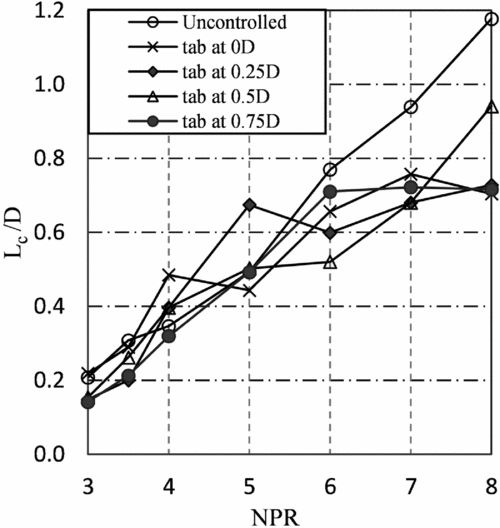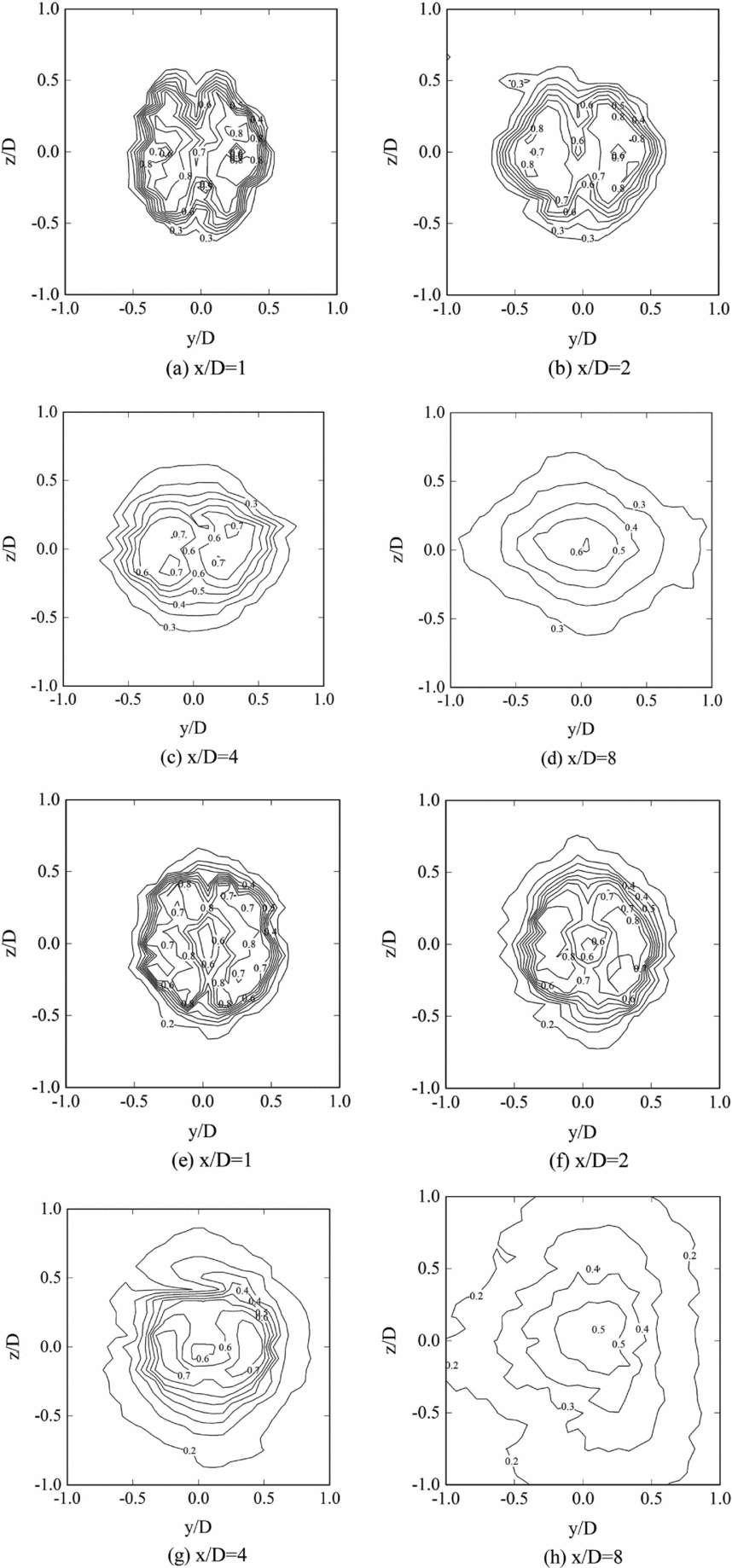NOMENCLATURE
- D
nozzle exit diameter
- D*
throat diameter
- Lc
core length of jet
- Md
design Mach number
- Me
actual Mach number
- NPR
nozzle pressure ratio (p0i/p b)
- pa
atmospheric pressure
- p b
backpressure
- pe
static pressure at nozzle exit
- p0t
pitot pressure in the jet field
- p0i
settling chamber pressure
- x
jet axis direction
- y
direction normal to tab
- z
tab direction
1.0 INTRODUCTION
Jet mixing enhancement caused by tabs, acoustic excitation, air-tab and so on has been studied extensively. Among them, tab is found to be an efficient mixing promoter. The mass transporting or mixing promoting small-scale vortices shed from the tab transport the low-momentum fluid entrained by the azimuthal vortices formed at jet boundary towards the jet centerline. This process results in enhanced mixing of jet fluid mass at a higher momentum with the entrained fluid mass. For subsonic jets, tabs placed at the nozzle exit increases jet spread rate and reduce the potential core length significantly(Reference Bradbury and Khadem1). Ahuja et al(Reference Ahuja and Brown2,Reference Ahuja, Manes, Massey and Calloway3) and Zaman et al(Reference Samimy, Reeder and Zaman4–Reference Zaman6) studied jet control with solid tabs and found that the tabs could not only increase the mixing in low-speed jets, but could promote the mixing of high-speed and high-temperature jets also. Two sources for the formation of stream-wise vortices, which distort the jet, were postulated(Reference Zaman, Reeder and Samimy7,Reference Zaman8) . Study on the effect of tab on turbulent boundary layer revealed that a tab could generate counter-rotating vortices that can stimulate strong ejection of boundary layer, leading to rapid mixing and thickening of turbulent boundary layer(Reference Gretta and Smith9).
Studies on the tab placement effect on jet mixing revealed that, locating tab upstream of the nozzle exit results in the generation of vortices which are in opposite nature to the vortices shed by tab at nozzle exit(Reference Reeder and Zaman10) and causes ejection of jet core, which is opposite to the ingestion caused by tab placed at exit, leading to reduced mixing. Investigation of tab geometry effect on jet mixing showed that the mixing caused by three-dimensional tab is less than that of two-dimensional tab of identical projected area(Reference Behrouzi and McGuirk11). Two serious disadvantages associated with use of tab is the momentum thrust loss caused by the tab due to the nozzle exit area blockage because of its presence at the exit and the drag penalty due to its presence in the jet. All attempts made to reduce the drag penalty due to tab presence were accompanied by significant reduction of mixing efficiency. The study by Rathakrishnan(Reference Rathakrishnan12) on limiting tab effect on supersonic jets in the range of Mach number from 1.6 to 2.0 showed that the limiting tab could perform efficiently in the presence of adverse pressure gradient also. In order to achieve increased jet mixing without thrust loss, Lovaraju and Rathakrishnan(Reference Lovaraju and Rathakrishnan13,Reference Lovaraju and Rathakrishnan14) studied jet mixing with a limiting tab of circular cross-section, termed cross-wire, located at 1D and 2D downstream of a sonic nozzle exit. Shifting the tab from the nozzle exit kept the nozzle exit area clean, leading to no loss in the momentum thrust associated with the jet. The cross-wire influenced the near field mixing of the sonic jet significantly, leading to an appreciable decrease of jet core length. Mixing enhancement caused by the cross-wire led to the weakening of the waves in the jet core for both sifted locations, for all the nozzle pressure ratios studied. A recent study by Maruthupandiyan and Rathakrishnan(Reference Maruthupandiyan and Rathakrishnan15) demonstrated that shifted tab could be used to modify the aerodynamic mixing of supersonic jet also, without any momentum thrust loss. Jet mixing promotion caused by shifted tab is found to increase with the increase of adverse pressure gradient (for nozzle pressure ratios below 5, for Mach 2 jet) and vice-versa. But this study was with short tabs located at diametrically opposite positions and not with limiting tab. In their recent study on jet control with corrugated shifted tab, Maruthupandiyan and Rathakrishnan(Reference Maruthupandiyan and Rathakrishnan16) showed that the corrugated shifted tab also can serve as an efficient mixing promoter without causing thrust loss. But the tab used in this study was a corrugated tab; hence, it is bound to induce more oscillations in the jet field, leading to the unsymmetrical propagation of the jet, which is undesirable from the application point of view. From this concise literature survey, it is explicit that only limited information on control of jet mixing without thrust penalty is available in open literature. Also, the studies reported on the control of supersonic jet with shifted tab are only with short and corrugated tabs. Therefore, it will be of value to jet literature if the control effectiveness of the plain limiting shifted tab on the aerodynamic mixing of supersonic jets is studied in the presence of different levels of pressure gradient at the nozzle exit. With this aim, control effectiveness of plain limiting tab placed at 0.25D, 0.5D and 0.75D downstream of exit of a Mach 2 axisymmetric nozzle issuing from the convergent-divergent nozzle, in the presence of 62%, 55%, 49%, 36%, 23%, 10% adverse pressure gradient and a marginal favourable pressure gradient of about 2.2%, corresponding to nozzle pressure ratio 3, 3.5, 4, 5, 6, 7 and 8 is investigated experimentally in this study.
2.0 EXPERIMENTAL SET-UP AND PROCEDURE
Experiments of the present study were conducted in the jet test facility shown in Fig. 1. High-pressure air from storage tanks, regulated with a pressure-regulating valve is expanded through a wide-angle diffuser in to the settling chamber. The high-pressure air at a desired total pressure in the settling chamber was expanded through the nozzle to generate the supersonic jet. The jet issuing from the nozzle was discharged into the lab environment at atmospheric pressure.

Figure 1. Jet set-up.
The total pressure in the settling chamber and pitot pressure variation along x, y and z directions, at specified x locations, were measured with a 16-channel net scanner™, 9116 transducer with a range of 0 –300 psi. The pressure data was acquired at the rate of 300 samples per second and the average was taken as the measured pressure. Thus, the pressure measured is the mean pitot pressure. A pitot tube of 0.4-mm inner diameter and 0.6-mm outer diameter, mounted on a rigid traverse, provided with a vernier scale, with its mouth facing the flow, was used for pressure measurement. The waves present in the core of the jet were visualised with a shadowgraph. The shadowgraph images of the waves were recorded with a 20-MP Sony Digital Single Lens Reflex camera.
The Reynolds number of the jet, based on the pitot probe outer diameter, is above 104 at all the tested nozzle pressure ratios. This Reynolds number is well above the troublesome Re number 500(Reference Rathakrishnan17); hence, the pressures measured are free from viscous error.
A convergent-divergent Mach 2 circular nozzle of 14°divergence was used to generate the jet. A flat limiting tab made of 1-mm thick brass strip, offering a geometrical blockage of 5% of the nozzle exit area was used to control the jet. Some views of the nozzle along with tab, and a schematic diagram of the tab, are shown in Fig. 2.
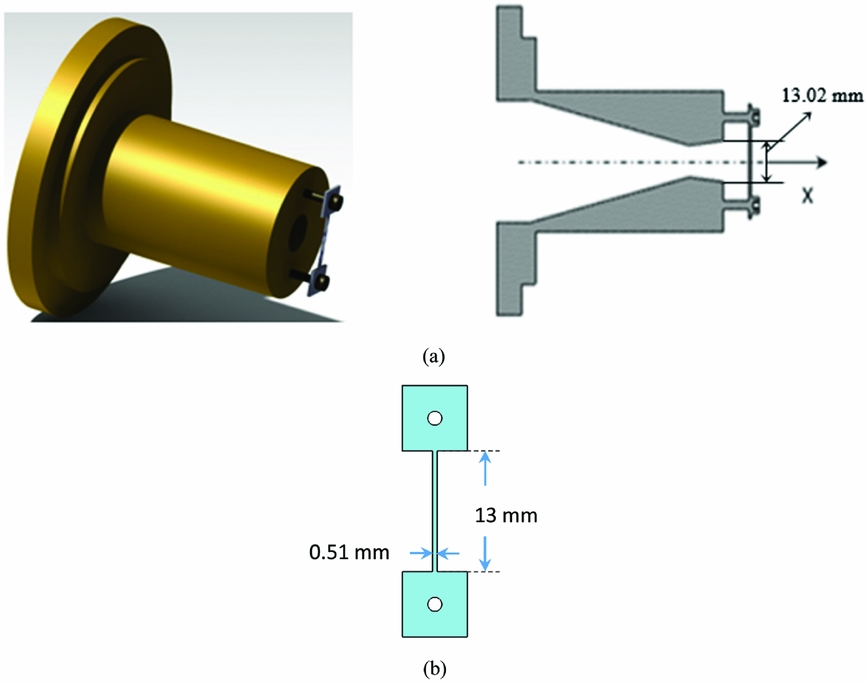
Figure 2. (a) Convergent-divergent nozzle with tab at 0.75D axial location and cut sectional view in xz plane (Dth = 10.02 mm, D = 13.02 mm, Ae /Ath = 1.688, Md = 2.0, design NPR = 7.824); (b) schematic diagram of limiting tab with dimensions.
3.0 UNCERTAINTY
The nozzle calibrated, after fabrication, was found to deliver Mach 2 jet with an uncertainty of 0.328%. The pitot pressure distribution measured at different grid points over the entire plane of the nozzle exit was found to be uniform, ensuring the Mach number over the exit plane is uniform. The uncertainty in the pitot pressure measured is ±1.17% and the uncertainty in the linear dimensions measured is ±1%.
4.0 ANALYSIS
The pitot pressure measured in the wave-dominated core of a supersonic jet cannot be converted to Mach number or velocity(Reference Rathakrishnan18). This is because the relations such as, the isentropic pressure-Mach number relation, normal shock relation connecting the pitot pressure in either side of the shock and Rayleigh pitot formula, which relates the ratio of the static pressure ahead of and pitot pressure behind a normal shock to the flow Mach number ahead of the shock, cannot be used for converting the pitot pressure measured in a wave dominated supersonic flow field such as the supersonic jet core, to Mach number, since the pitot pressure behind the shock at the nose of the pitot probe alone can be measured accurately in this kind of flow field. That is, the actual total pressure cannot be measured in a wave-dominated supersonic flow field. However, direct use of the pitot pressure variation with the distance along the jet axis can be exploited for discerning the jet characteristics, such as the core length, characteristic decay and the decay in the self-similar region(Reference Rathakrishnan12).
5.0 CENTERLINE DECAY
Pitot pressure decay along the jet centerline is a measure of jet mixing, indicating the mixing of the ambient fluid entrained by the jet with the jet mass issuing from the nozzle(Reference Rathakrishnan18). Faster decay is an indication of faster mixing of the jet with the mass entrained from the surrounding. Therefore, to investigate the aerodynamic mixing of the jet, controlled with plain limiting tab (PL) located at 0.25D, 0.5D and 0.75D, from the nozzle exit, pitot pressure distribution along the jet axis (x-direction) from nozzle exit (0D) to 20D was measured at 1-mm intervals. These measurements were done for nozzle pressure ratio in the range from 3 to 8, covering a range of adverse pressure gradient to a marginally underexpanded state for the Mach 2 jet, for which the nozzle pressure ratio for correct isentropic expansion is 7.82. In addition to these shifted tabs, tab at nozzle exit; 0D, was also tested for comparison. The measured pitot pressure, p 0t, distribution is non-dimensionalised with the settling chamber stagnation pressure, p0i , and the axial distance; x is made non-dimensional with the nozzle exit diameter D.
Decay of the uncontrolled jet (jet without tab) and the jet controlled with tab at 0D, 0.25D, 0.5D and 0.75D from the nozzle exit, in the pressure of adverse pressure gradient of about 61%, corresponding to NPR 3, are presented in Fig. 3. At this NPR, the jet is highly overexpanded, with pe/pa = 0.383. At this high level of adverse pressure gradient, centerline decay of the jet for tab at 0.75D is faster than the decay of uncontrolled jet and tab at 0D. Uncontrolled jet core is about 2.7D, and the core for controlled with tab at 0D, 0.25D, 0.5D and 0.75D are 2.84D, 1.92D, 2.0D and 1.84D, respectively. Shorter core for the shifted tabs relative to tab at 0D implies the mixing promotion caused by the mass transporting small-scale vortices shed from the shifted tab establishes an environment, which is more congenial for mixing promotion than the mixing environment caused by the tab at nozzle exit. Among the shifted tabs, tab at 0.75D is found to be the most efficient mixing promoter, resulting in the shortest core of 1.84D compared to other shifted tabs. Another important feature seen from this plot is that the better mixing caused by tab at 0.75D is confined to the core and characteristic decay zones only. In the far field, the decay of uncontrolled and controlled jets is almost identical. In the pressure of adverse pressure gradient of about 61%, the limiting tab at 0.75D enhances the jet mixing leading to core length reduction of about 32%.
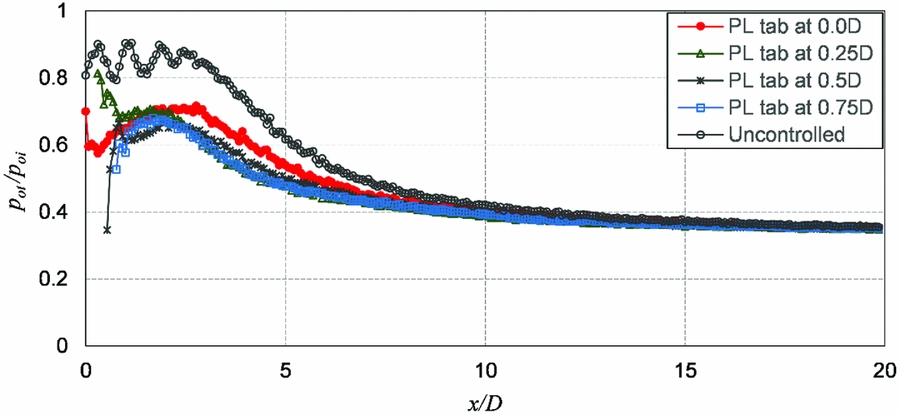
Figure 3. Centerline decay of Mach 2 circular jet at NPR 3.
The centerline decay results for NPR 3.5 are presented in Fig. 4. This is the case of reduced adverse pressure gradient compared to NPR 3. With increase of NPR to 3.5 from 3, the adverse pressure gradient comes down from 61% to 55%. Even this small decrease, only about 6%, of adverse pressure gradient causes a significant change in the decay of both controlled and uncontrolled jets. In the presence of this level of adverse pressure gradient, the mixing caused by the small-scale vortices shed from the edges of the tab at 0.25D found to be the best. The core length reduction caused by tab at 0.25D is about 35%, which is so large compared to just 6% of core length reduction associated with tab at 0D. Even though the distance between limiting tab at 0D and 0.25D is small, the core length reduction caused by this marginal shift in tab location is found to be significant, indicating that the combined effect of the pressure gradient and the pressure-hill formed at the face of the tab plays a dominant role in dictating the size of the mixing promoting vortices shed by the tab. At this adverse pressure gradient of 55%, the mixing promoting environment established by the small-scale vortices shed from the tab at 0.25D and the mass entraining large-scale structures formed at the jet boundary is found to be a superior mixing promoter than that associated with the tab at nozzle exit (0D). Also, for tab at 0.5D there is a gradually increasing pitot pressure region, upstream of the location where the characteristic decay begins. This subsonic region gains momentum and pressure begins to increase and attains peak value at 3.38D. The limiting tab at nozzle exit and 0.5D from nozzle exit causes this gradual increase of pressure without any oscillation. This may be because of the strong detached shock formed in front of the limiting tabs, causing severe pressure loss. From these results, it is evident that the shock formed ahead of limiting tab strongly influences the jet propagation. This effect seems to be sensitive to the level of expansion at nozzle exit and the location of the tab from nozzle exit.
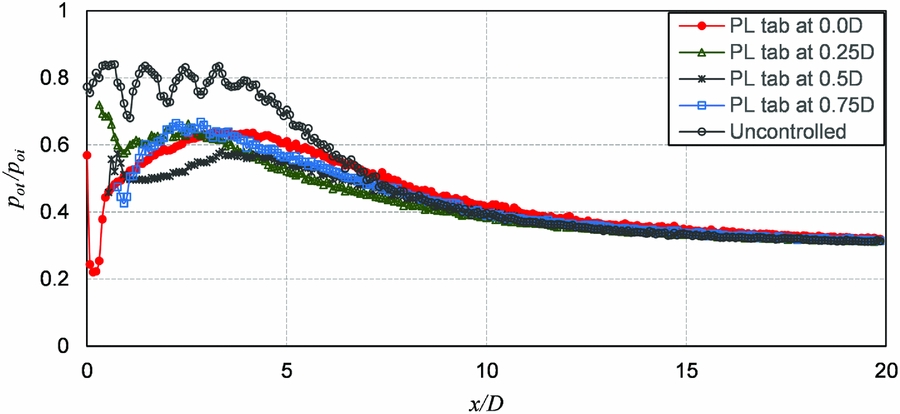
Figure 4. Centerline decay of Mach 2 circular jet at NPR 3.5.
Jet centerline decay results for NPR 4, which is a state of 49% negative pressure level at the Mach 2 nozzle exit of the present study, are given in Fig. 5. At this level of adverse pressure gradient, the jet mixing promotion caused by the shifted tab at 0.75D found to the highest. Also, tabs at 0D, 0.25D and 0.5D retard the mixing, leading to an increase in the jet core length compared to the lower NPRs. Core length for tab at 0D, 0.25D and 0.5D are comparable to the uncontrolled jet core, implying that the effect of the mixing promotion caused by the small-scale vortices shed from the tab at these locations is insignificant in the near filed. However, for tab at 0.75D the jet core length comes down by about 8%.
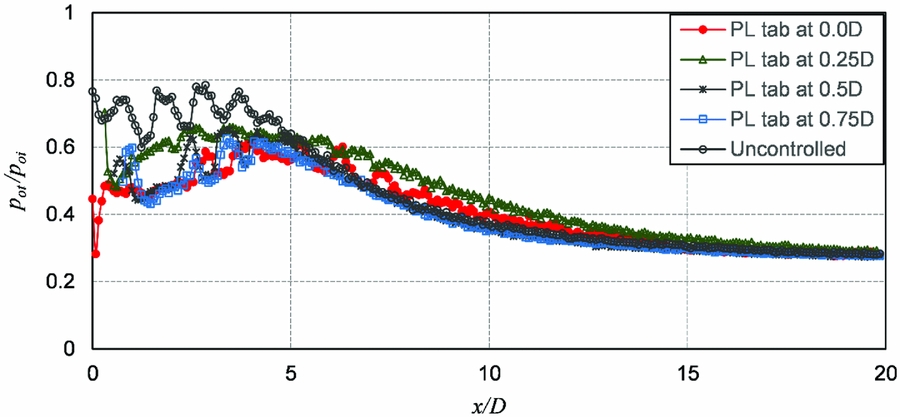
Figure 5. Centerline decay of Mach 2 circular jet at NPR 4.
When the nozzle pressure ratio is increased to 5, the adverse pressure gradient at the nozzle exit becomes 36%. For this level of adverse pressure gradient, the centerline decay results of the controlled and uncontrolled jet are shown in Fig. 6. It is seen that, increase of NPR results in considerable reduction in the mixing promotion caused by shifted tab, leading to protection of jet core. Tab at 0D could able to reduce the jet core length by about 10%, whereas tab at 0.25D reduces the jet mixing to an extent leading to about 36% increase in core length. The jet core length for tab locations 0.5D and 0.75D are comparable to the core of uncontrolled jet. But these tabs render the waves in the jet core to become weaker than the waves in the core of the uncontrolled jet. It is interesting to note that the mixing retardation caused by the tab located at 0.25D persists in all three zones of the jet. But in the fully developed zone, the decay for tabs at 0D, 0.5D and 0.75D are identical to uncontrolled jet decay.
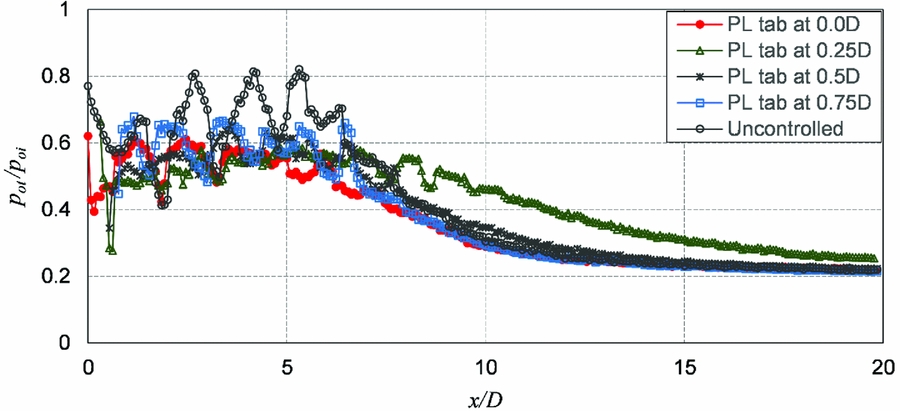
Figure 6. Centerline decay of Mach 2 circular jet at NPR 5.
The adverse pressure gradient at the nozzle exit comes down to 23% when the NPR goes up from 5 to 6. Jet centerline decay results for NPR 6 are shown in Fig. 7. The core length of the uncontrolled jet is 10D. Whereas, for tab at 0D, 0.25D, 0.5D and 0.75D, the core length is about 8.53D, 7.78D, 6.76D and 9.23D, respectively. It is seen that, in the presence of adverse pressure gradient of 23%, the mixing promoting environment established by tab at 0.5D location is the best, leading a core reduction of about 32.4%. The corresponding core length reduction for tab locations 0D, 0.25D and 0.75D are only 14.7%, 22.2%, and 7.7%, respectively. Also, the amplitude of pitot pressure oscillation in the core of the jet for tab at 0.5D is considerably smaller compared to other tab locations. This implies that the near-field mixing enhancement caused by the shifted tab at 0.5D is superior not only from an aerodynamic mixing point of view but from an aero-acoustics viewpoint also, since the weaker the shocks the lesser would be the shock-associated noise.
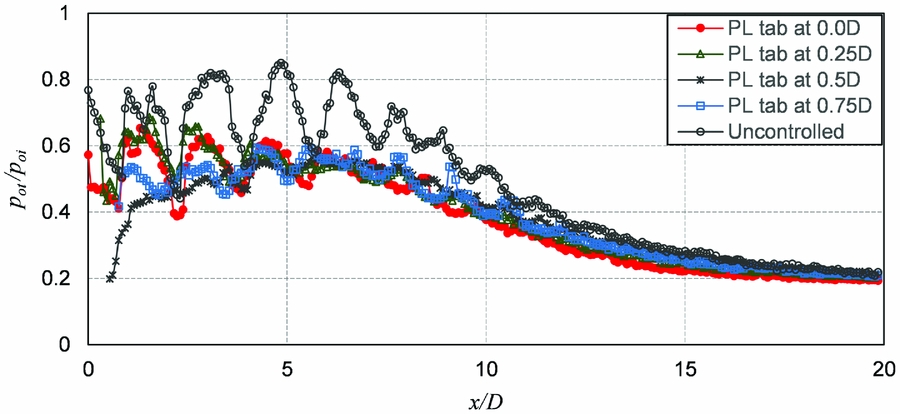
Figure 7. Centerline decay of Mach 2 circular jet at NPR 6.
Decay results for NPR 7, which correspond to an expansion level of pe/pa = 0.895, are shown in Fig. 8. In the presence of an adverse pressure gradient of around 10%, waves in the core of both the controlled and uncontrolled jet become stronger than NPR 6. But the waves in the controlled jet are considerably weaker than those in the uncontrolled jet. For this nozzle pressure ratio, 0.5D tab is found to be the best mixing promoter, leading faster decay than the jets controlled with tab at 0D, 0.25D and 0.75D, in the core region as well as in the characteristic decay zone. The waves present in the core of the jet controlled with tab at 0.5D are found to be considerably weaker than the uncontrolled jet with the 0D tab. Though both the shifted limiting tabs at 0.25D and 0.5D result in the same core length of about 8.84D, the waves in the core of the jet controlled with tab at0.25D tab are stronger. Unlike NPR 6, for which the mixing promotion associated with the tabs are not impressive, at NPR 7 all tabs, irrespective of location, promote mixing considerably, leading to about 19%, 27%, 27% and 23% core reduction, respectively, for tab at 0D, 0.25D, 0.5D and 0.75D locations.
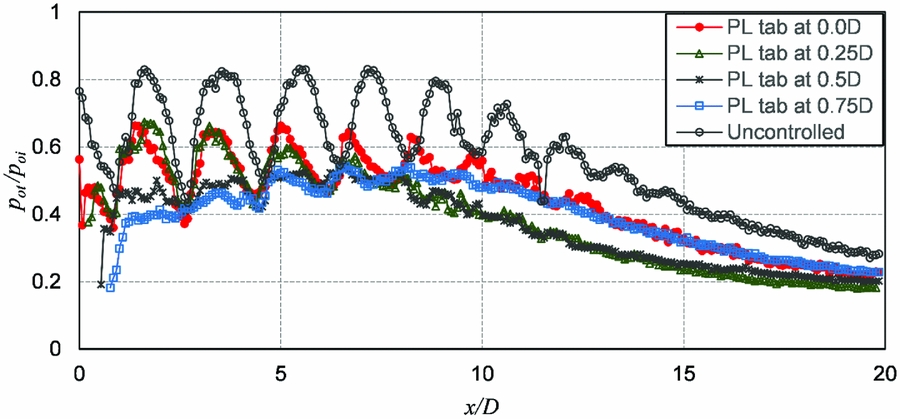
Figure 8. Centerline decay of Mach 2 circular jet at NPR 7.
Figure 9 compares jet centerline decay for NPR 8, which is a state of a marginal favourable pressure gradient of about 2.2%. Pitot pressure oscillations of considerable amplitude in the core of the jet imply the presence of strong wave in the core of both controlled and uncontrolled jets. The core for the uncontrolled jet extends beyond 15D. The tab at 0D reduces the amplitudes of pressure oscillation and reduces the core length from 15D to 9.15D. The jet decay caused by 0.25D tab is comparable to the decay caused by 0D tab, except a marginal increase in core length. But the limiting tab at 0.5D and 0.75D weakens the waves in the jet core to a great extent, as reflected by the reduced amplitudes of pitot pressure oscillation and smaller number of shock cells. The core length reduction for 0D and 0.75D tab is about 40.2% and 39.2%, respectively. Though the core length reduction associated with 0.75D tab is comparable to 0D tab, the former keeps the nozzle exit clean and thereby allows the nozzle to generate full momentum thrust, unlike the tab at 0D, which spoils the nozzle exit area leading to reduction of jet Mach number and momentum thrust loss corresponding to the geometrical blockage caused by its presence.
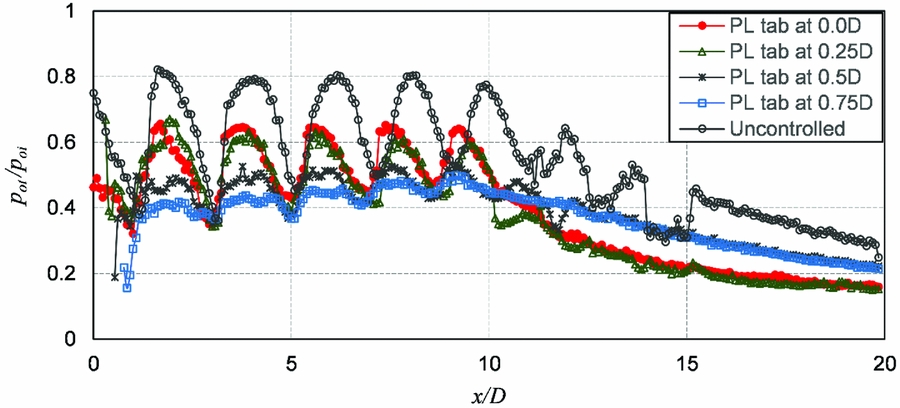
Figure 9. Centerline pitot pressure decay at NPR 8.
6.0 CORE LENGTH VARIATION WITH TAB LOCATION AND EXPANSION LEVEL
Non-dimensional core length (Lc/D) variation with tab location and nozzle expansion level (NPR) is presented in Fig. 10. It is seen that both these parameters; tab location and level of expansion at the nozzle exit strongly influence the mixing modification, caused by the small-scale vortices shed from the tab, leading to a considerable change in the near-field mixing, as reflected by the variation of core length. Core of the uncontrolled jet and the jet controlled with shifted tab at 0.75D increases monotonically with the nozzle pressure ratio. Also, for NPR in the range from 5 to 8, the near-filed mixing promotion caused by the mass transporting vortices shed from the edges of tab at 0.75D is considerably larger than the mixing experienced by the uncontrolled jet, as reflected by the shorter core for tab at 0.75D. For most combinations of tab location and NPR, the controlled jet has shorter core than the uncontrolled jet. In the presence of a mild favourable pressure gradient of about 2.2%, mixing caused by tab at 0D, 0.25D and 0.75D are almost identical, but significantly larger than the mixing caused by the tab at 0.5D.
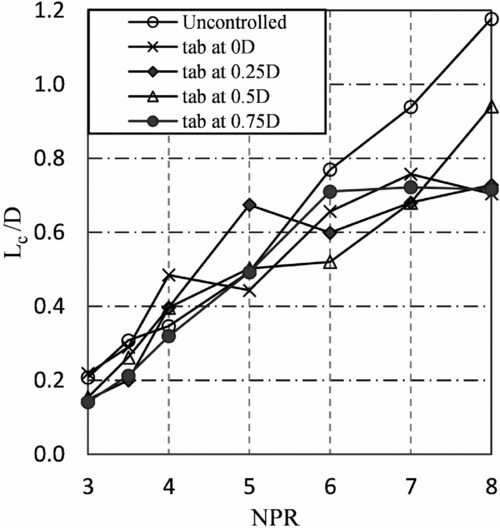
Figure 10. Core length variation with NPR and tab location.
6.1 Isobaric contours
To assess jet spread in the yz-plane, at specified x/D stations, detailed pressure distribution over the yz-plane, at specified x/D locations were measured. These measurements were done over the entire yz-plane, without assuming any symmetry. Pressure at different grid points over the complete yz-plane was measured at 1 mm intervals. Measured pitot pressure, p0t, was made nondimensional with the corresponding settling chamber pressure, p0i. Isobaric contours in the yz-plane, at some axial locations of the jet controlled with tab at 0D and 0.5D, at NPR 6, are presented in Fig. 11. Pressure contours for the jet controlled with the limiting tab at 0D and 0.5D, at x/D = 1, 2, 4 and 8 stations, are shown in Fig. 11. It is seen that, the jet spread for tab at 0.5D is considerably larger than that for tab at 0D, at all x/D stations. The pitot pressure levels in the field of the jet controlled with the shifted tab at 0.5D are lesser than that for tab at 0D. This implies that the tab at 0.5D is a superior mixing promoter than the tab at 0D. Same trend is observed in the plane normal to the jet axis, at x/D = 2 station also. At x/D = 4, as seen in Fig. 11(c) and (g), the jet spread in the direction normal to the tab is larger, for tab at 0D, whereas for the jet controlled with tab at 0.5D spread along the tab direction is larger. This behaviour continues at all axial locations. Larger spread in z-direction might be the cause for the better mixing capability of shifted 0.5D tab than the tab at 0D. This superior mixing capability of the shifted tab at 0.5D is reflected as shorter core in the centerline pitot pressure decay results. At axial location 8D (Fig. 11(d) and (h)), the maximum pitot pressure level for tab at 0D is p0t/p0i = 0.6, whereas the value of p0t/p0i for the jet controlled by tab at 0.5D is 0.5. Also, the cross-sectional area of the jet for tab at 0.5D is comparatively larger than tab 0D. This demonstrates that the mixing promoting environment established by the small-scale vortices shed from the edges of tab at 0.5D is better than that caused by the vortices shed from the tab at 0D. The iso-baric contour plots shown in Fig. 11 compliments the findings from the centerline decay results (Figs. 3–9).
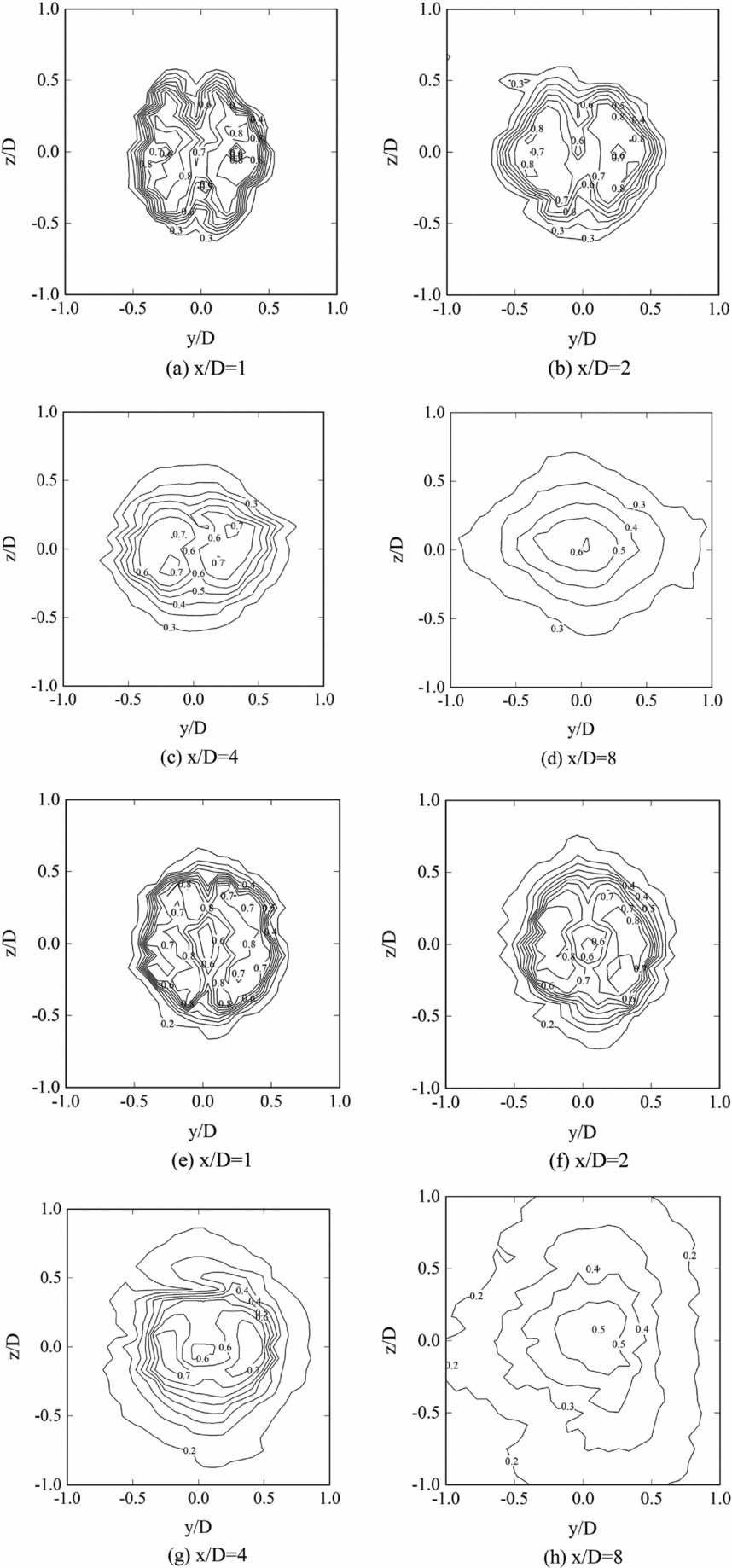
Figure 11. Isobaric (p0t /poi) contours for tab at 0D; (a), (b), (c) and (d) and 0.5D; (e), (f), (g), (h), for pe/pa = 0.767.
6.2 Shadowgraph images
The waves present in the in xz-plane of the jets controlled with tab at 0D and 0.5D, at different levels of expansion, are shown in Fig. 12. The detached shock formed at the face of the tab seems to influence the near field mixing of the jet very strongly. At a given NPR, the shock cell structure in the jet core is greatly influenced by the tab location. This is because the detached shockwave envelope at the face of the tab at 0D disturbs flow expansion right from nozzle exit, whereas for tab at 0.5D, the jet at the nozzle exit would expand freely up to the tab location. The additional waves generated due to the presence of shifted tabs are found to cause noticeable change of the mixing characteristics of the jet than tab at 0D. From Fig. 12(b), it can be observed that, the jet width along the tab direction is more for jet controlled by the limiting tab at 0.5D compared to the limiting tab at 0D. This compliments the higher spread along the tab observed for tab at 0.5D (Fig. 11). Also, the waves present in the core of the jet controlled with shifted tab are weaker and more in number compared to the jet controlled by tab at nozzle exit. Because of these weak waves, the amplitudes of pitot pressure oscillation in the core of the jet controlled with shifted limiting tab are lower than that for tab at nozzle exit, as seen in the centerline decay plots in Figs. 3–9.
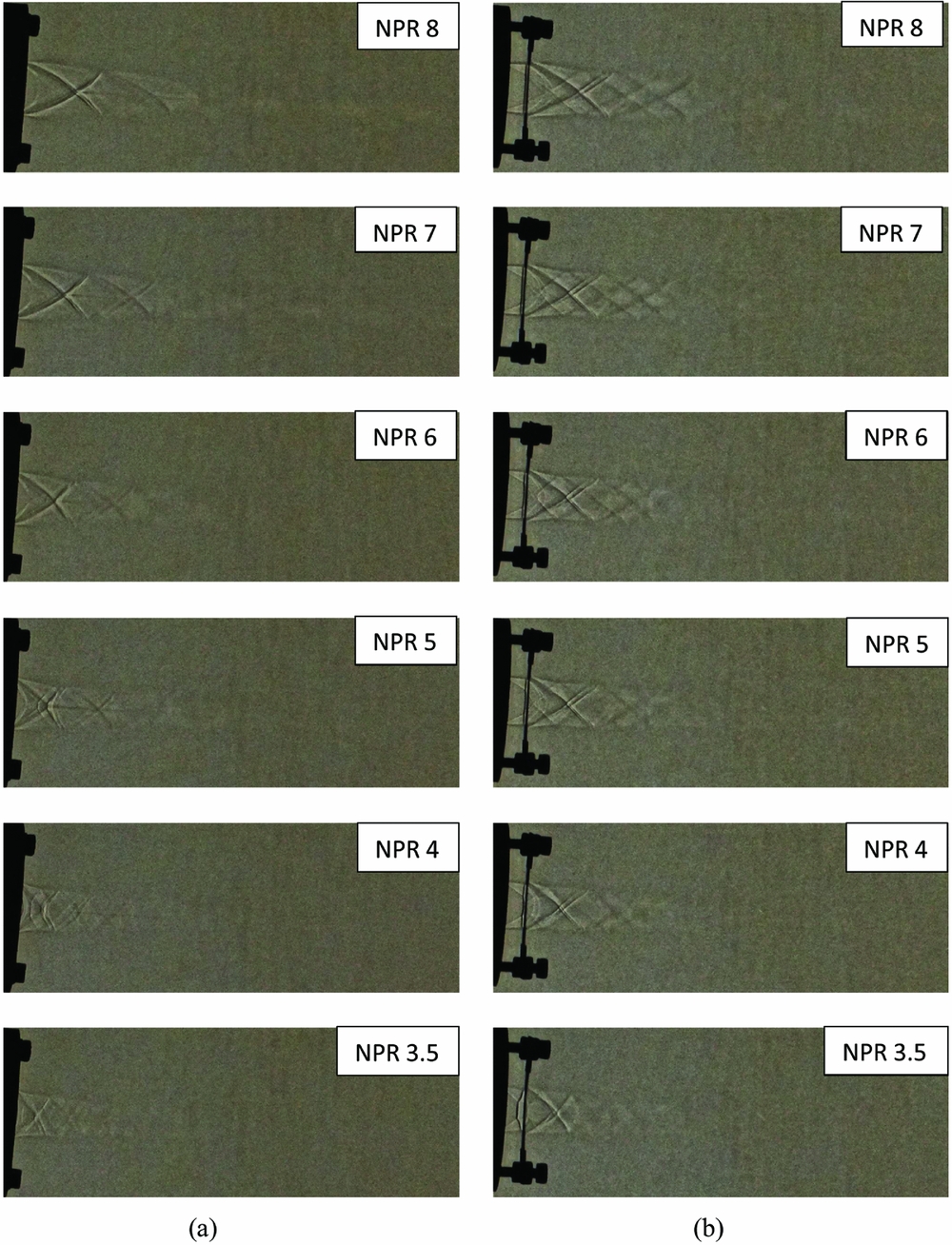
Figure 12. Shadowgraph images of controlled jet with limiting tab at different location and NPR; (a) tab at 0D; (b) tab at 0.5D.
The results of this study demonstrate that positioning tab at stations downstream of nozzle exit, keeping the exit aerodynamically clean, so that the jet would generate the full momentum thrust it is capable of, can control supersonic jets at different levels of expansion. The results also show that the combined effect of tab location and the level of expansion at the nozzle exit strongly influence the jet mixing. Also, the strength of the detached shock envelope at the face of the tab has a strong role in dictating the size of the mixing promoting small-scale vortices shed by the tab.
7.0 CONCLUSIONS
The results of this study reveal that the aerodynamic mixing of supersonic free jets can be modified with shifted limiting tab, without losing the precious momentum thrust that would be generated by the jet nozzle. In the presence of a mild positive pressure gradient of 2.2%, shifted tab at 0.75D is found to be a better mixing promoter than the tab at nozzle exit (0D), 0.25D and 0.5D. For overexpanded jets, with adverse pressure gradient at the nozzle exit, mixing promoting capability of tab at nozzle exit comes down considerably, and is found to be less than the shifted tabs. In the presence of an adverse pressure gradient of about 55%, the jet core length reduction caused by tab at 0.25D, 0.5D and 0.75D are 35%, 15% and 31%, respectively, whereas for tab at 0D the core length reduction is only 6%. At a marginally underexpanded state corresponding to NPR 8, the core length reduction caused by the limiting tab at 0D is 40.2%, which is closer to the reduction of 39.21%, caused by the shifted tab at 0.75D. The corresponding core length reduction for same tab at 0.25D and 0.5D are 38.16% and 20%, respectively.



